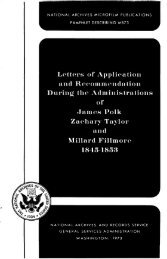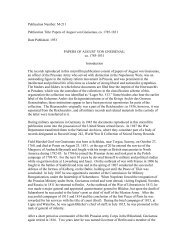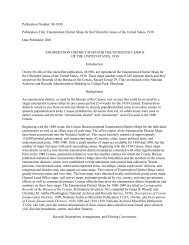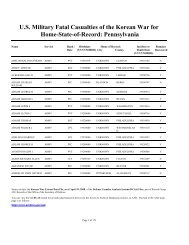HITLER'S SHADOW - National Archives and Records Administration
HITLER'S SHADOW - National Archives and Records Administration
HITLER'S SHADOW - National Archives and Records Administration
You also want an ePaper? Increase the reach of your titles
YUMPU automatically turns print PDFs into web optimized ePapers that Google loves.
The guerrillas said that most UPA fighters were “ordinary” B<strong>and</strong>erists, but<br />
others also listed Slovak Hlinka Guards, Ukrainian SS from the 14th Grenadier<br />
Waffen-SS (Galicia) Division, <strong>and</strong> “escaped German SS men” as those among<br />
the UPA forces. Most UPA fighters recognized B<strong>and</strong>era as their leader. 33 UPA<br />
refugees also viewed themselves as refitting rather than quitting. One source<br />
said in September 1947 that B<strong>and</strong>erists were recruiting more members in DP<br />
camps, their main recruiter being Anton Eichner, a former SS officer. 34 Other<br />
interrogations revealed that, “the UPA foresees an end to communism within<br />
the very near future… Once the war comes… they hope to… fight either as<br />
front shock troops or gain in their old capacity, as guerilla fighters behind the<br />
Russian lines….” 35<br />
By August 1947 B<strong>and</strong>erists were represented in every Ukrainian DP<br />
camp in the U.S. zone as well as in the British <strong>and</strong> French zones. They<br />
had a sophisticated courier system reaching into the Ukraine. The CIC<br />
termed B<strong>and</strong>era himself, then in Munich, as “extremely dangerous.” He was<br />
“constantly en route, frequently in disguise,” with bodyguards ready to “do<br />
away with any person who may be dangerous to [B<strong>and</strong>era] or his party.” UPA<br />
fighters said that B<strong>and</strong>era was “looked upon as the spiritual <strong>and</strong> national hero<br />
of all Ukrainians….” 36<br />
B<strong>and</strong>erists represented themselves as fighting a “heroic Ukrainian resistance<br />
against the Nazis <strong>and</strong> the Communists” which had been “misrepresented <strong>and</strong><br />
maligned” by “Moscow propag<strong>and</strong>a.” B<strong>and</strong>era, they never tired of saying,<br />
had been arrested by the Nazis <strong>and</strong> held in Sachsenhausen. Now he <strong>and</strong> his<br />
movement fought “not only for the Ukraine, but also for all of Europe.” 37 As<br />
for B<strong>and</strong>erist activities before <strong>and</strong> during the war, U.S. intelligence officials<br />
seemed to underst<strong>and</strong> little beyond B<strong>and</strong>era’s implication in the Pierecki<br />
assassination. They understood nothing of the B<strong>and</strong>erist role in ethnic<br />
cleansing during the war.<br />
CIC agents also used UPA informants to ferret out Soviet spies from<br />
Ukrainian DP camps who slipped into Germany with UPA partisans. The<br />
Soviets had penetrated the UPA b<strong>and</strong>s that made their way west. 38 Yuri<br />
Lopatinski travelled to the Ukrainian camp in Deggendorf in October 1947<br />
to find Soviet agents. 39 UPA members could also provide intelligence on the<br />
Soviets since, according to UPA officers, they had “done a fairly thorough job<br />
Collaborators | 79



